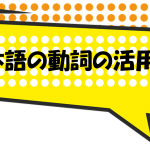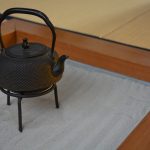
目次
What is tai/たい
tai/たい is an auxiliary verb, which is used to express the concept of wishing or wanting to do something. tai/たい is put after a verb and make a verb phrase "verb + tai/たい." This phrase can be translated as "want to + verb." Keep in mind that auxiliary verbs always come after verbs in Japanese.
How to use tai/たい in a sentence
To master how to use tai/たい properly you should know for the first thing is that auxiliary verbs always come after a verb in Japanese.
For the second thing there are three different types of verb in Japanese. They are the u regular verb, the ru regular verb and irregular verb.
If you are not familiar with the types of verb and verb forms, click the below link to check it out.
https://jpgrammar.com/verbforms/
For the third thing you need to learn how tai/たい connect with the three different types of verbs.
Let's learn how to make a verb phrase "verb + tai/たい."
How to use tai/たい with verbs
The u regular verbs have five basic conjugations, which can be called the u form, the i form, the a form, the e form and the o form. The form of verbs ends with the sound u is called the u form and the same rule is applied to all verb forms.
Basically, the form of Japanese verbs has to be changed depending on the auxiliary verb that is placed immediately after the verb.
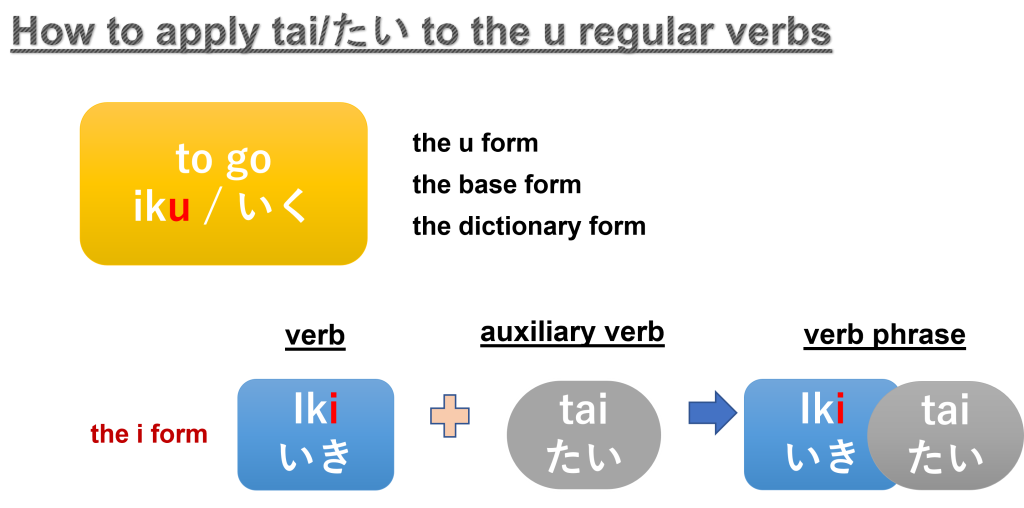
tai/たい follow the i form of the u regular verbs. Here tai/たい follows "iki/いき" which is the i form of the verb "iku/いく."
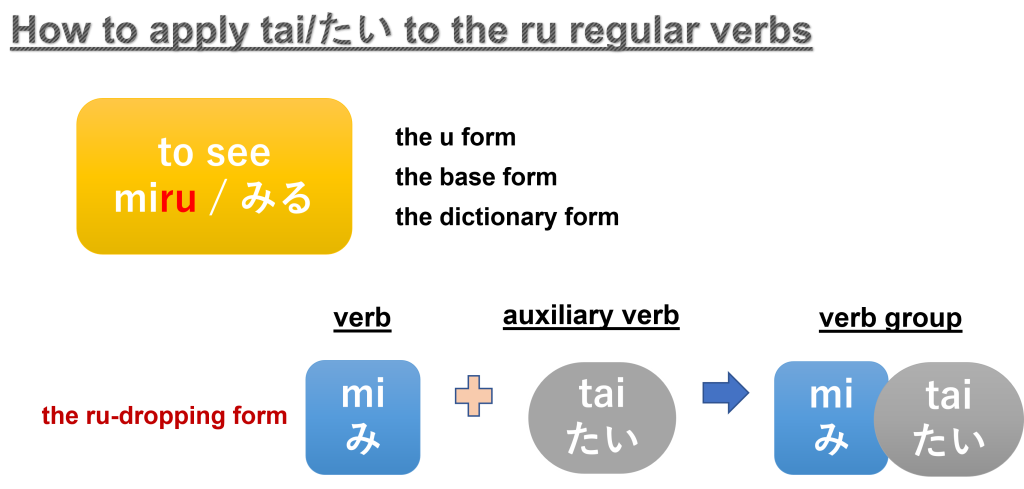
The ru regular verbs have the ru-dropping form instead of the i form and the a form of the u regular verbs. tai/たい follow the ru-dropping form of the ru regular verbs. Here tai/たい follows "mi/み" which is the ru-dropping form of the verb "miru/みる."
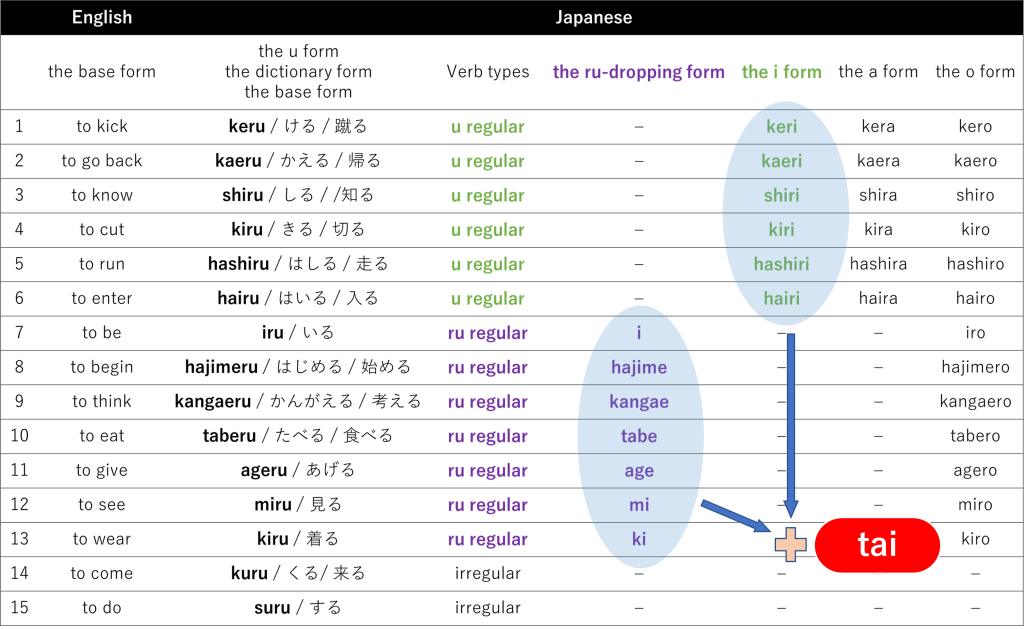
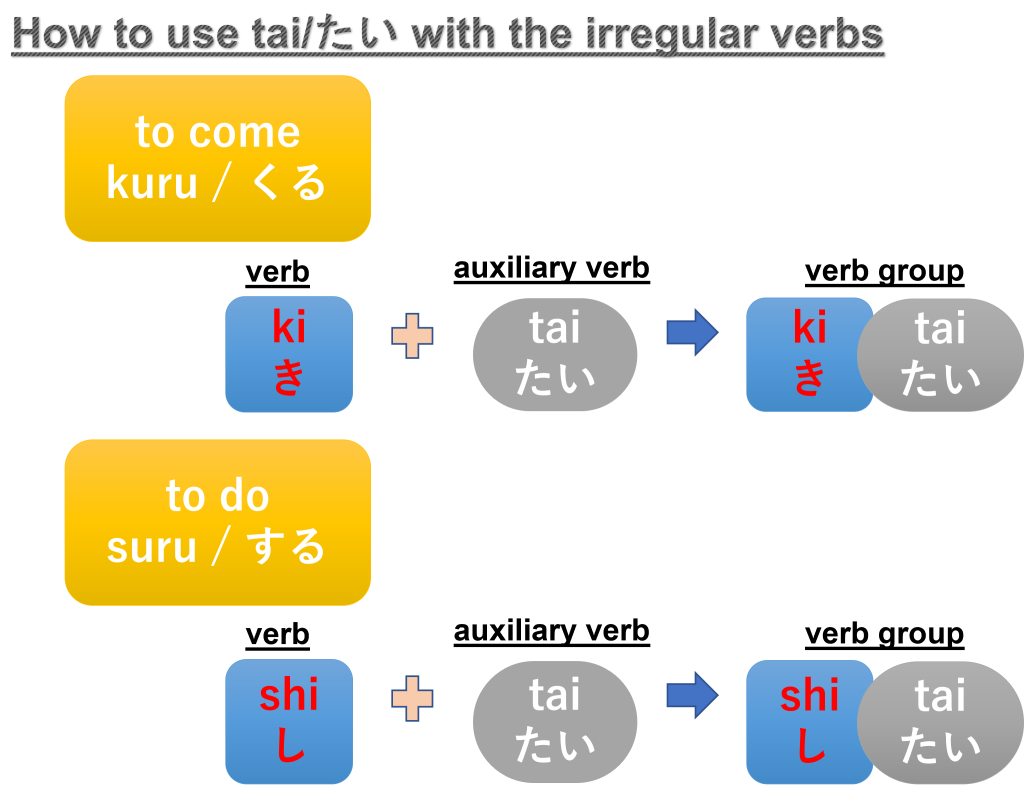
There are only two irregular verbs in Japanese and they are "kuru/くる" which means to come and "suru/する" which means to do. When tai/たい comes after the verb "kuru/くる", it becomes "ki/き." When tai/たい comes after the verb "suru/する", it becomes "shi/し."
Let's look at some examples:
<Example 1>
Ashita tookyoo ni iku.
あした とうきょう に いく。
明日 東京 に 行く。
[tomorrow Tokyo ni/に go]
I'm going to Tokyo tomorrow.
Ashita tookyoo ni iki-tai.
あした とうきょう に いきたい。
明日 東京 に 行きたい。
[tomorrow Tokyo ni/に go-want]
I want to go to Tokyo tomorrow.
Here, "go" is "iku/いく" in Japanese and "want to go" is "iki-tai/いきたい" in Japanese. "iku/いく" is a u regular verb and its i form is "iki/いき."
<Example 2>
Ima kara eega wo miru.
いま から えいが を みる。
今 から 映画 を 観る。
[now from movie o/を watch]
I'm going to watch a movie now.
Ima kara eega wo mi-tai.
いま から えいが を みたい。
今 から 映画 を 観たい。
[now from movie o/を watch-want]
I want to watch a movie now.
Here, "watch" is "miru/みる" in Japanese and "want to watch" is "mi-tai/みたい" in Japanese. "miru/みる" is a ru regular verb and its ru-dropping form is "mi/み."
The past form of "tai/たい"
The past form of "tai/たい" is "takatta/たかった."
"takkatta/たかった" can be used with verbs in the same way as "tai/たい."

Let's look at some examples:
<Example 3>
Tookyoo ni iki-tai.
とうきょう に いきたい。
東京 に 行きたい。
[Tokyo ni/に go-want]
I want to go to Tokyo.
Tookyoo ni iki-takatta.
とうきょう に いきたかった。
東京 に 行きたかった。
[Tokyo ni/に go-wanted]
I wanted to go to Tokyo.
Here, "takatta/たかった" which is the past form of "tai/たい" follows "iki/いき" which is the i form of "iku/いく."
<Example 4>
Eega wo mi-tai.
えいが を みたい。
映画 を 観たい。
[movie o/を watch-want]
I want to watch a movie.
Eega wo mi-takatta.
えいが を みたかった。
映画 を 観たかった。
[movie o/を watch-wanted]
I wanted to watch a movie now.
Here, "takatta/たかった" which is the past form of "tai/たい" follows "mi/み" which is the ru-dropping form of "miru/みる."
The Negative "tai/たい"
The negative "tai/たい" is "taku-nai/たくない." "taku-nai/たくない" consists of two auxiliary verb that are "tai/たい" and "nai/ない."
In Japanese two auxiliary verbs can be combined like this.
"nai/ない" is a auxiliary verb that is used to change the meaning of the sentence from positive to negative.
When "nai/ない" comes after "tai/たい", "tai/たい" changes its form to "taku/たく." You can interpret "taku/たく" in a way that it is connective form of "tai/たい" for "nai/ない"
"taku-nai/たくない" can be used with verbs in the same way as "tai/たい."
The past form of "taku-nai/たくない" is "taku-nakatta/たくなかった." "taku-nakatta/たくなかった" is consist of "taku/たく" and "nakatta/なかった" which is the past form of "nai/ない."
"taku-nakatta/たくなかった" can also be used with verbs in the same way as "tai/たい."

Let's look at some examples:
<Example 3>
Tookyoo ni iki-tai.
とうきょう に いきたい。
東京 に 行きたい。
[Tokyo ni/に go-want]
I want to go to Tokyo.
Tookyoo ni iki-taku-nai.
とうきょう に いきたくない。
東京 に 行きたくない。
[Tokyo ni/に go-want-not]
I don't want to go to Tokyo.
Here, "taku-nai/たくない" which is the negative "tai/たい" follows "iki/いき" which is the i form of "iku/いく."
<Example 4>
Eega wo mi-tai.
えいが を みたい。
映画 を 観たい。
[movie o/を watch-want]
I want to watch a movie.
Eega wo mi-taku-nakatta.
えいが を みたくなかった。
映画 を 観たくなかった。
[movie o/を watch-want-not(past)]
I didn't want to watch a movie now.
Here, "taku-nakatta/たくなかった" which is the past form "taku-nai/たくない" follows "mi/み" which is the ru-dropping form of "miru/みる."
The formal "tai/たい"
The formal "tai/たい" is "tai-desu/たいです." "tai-desu/たいです" consists of two auxiliary verb that are "tai/たい" and "desu/です."
"desu/です" is a auxiliary verb that is used to show politeness.
"tai-desu/たいです" can be used with verbs in the same way as "tai/たい."
The past form of "taku-desu/たいです" is "takatta-desu/たかったです." "takatta-desu/たかったです" is consist of "takatta/たかった" which is the past form of "tai/たい"and "desu/です."
"takatta-desu/たかったです" can also be used with verbs in the same way as "tai/たい."

Let's look at some examples:
<Example 3>
Tookyoo ni iki-tai.
とうきょう に いきたい。
東京 に 行きたい。
[Tokyo ni/に go-want]
I want to go to Tokyo.
Tookyoo ni iki-tai-desu.
とうきょう に いきたいです。
東京 に 行きたいです。
[Tokyo ni/に go-want-polite]
I want to go to Tokyo.
Here, "tai-desu/たいです" which is the formal "tai/たい" follows "iki/いき" which is the i form of "iku/いく."
<Example 4>
Eega wo mi-tai.
えいが を みたい。
映画 を 観たい。
[movie o/を watch-want]
I want to watch a movie.
Eega wo mi-takatta-desu.
えいが を みたかったです。
映画 を 観たかったです。
[movie o/を watch-wanted-polite]
I wanted to watch a movie now.
Here, "takatta-desu/たかったです" which is the past form of "tai-desu/たいです" follows "mi/み" which is the ru-dropping form of "miru/みる."
The negative formal "tai/たい"
The negative formal "tai/たい" is "taku-nai-desu/たくないです." "taku-nai-desu/たくないです" consists of three auxiliary verb that are "tai/たい", "nai/ない" and "desu/です."
In Japanese three auxiliary verbs can be combined like this.
"taku-nai-desu/たくないです" can be used with verbs in the same way as "tai/たい."
The past form of "taku-nai-desu/たくないです" is "taku-nakatta-desu/たくなかったです." "taku-nakatta-desu/たくなかったです" is consist of "taku/たく" which is the connective form of "tai/たい" for "nai/ない", "nakatta/なかった" which is the past form of "nai/ない"and "desu/です."
"taku-nakatta-desu/たくなかったです" can also be used with verbs in the same way as "tai/たい."
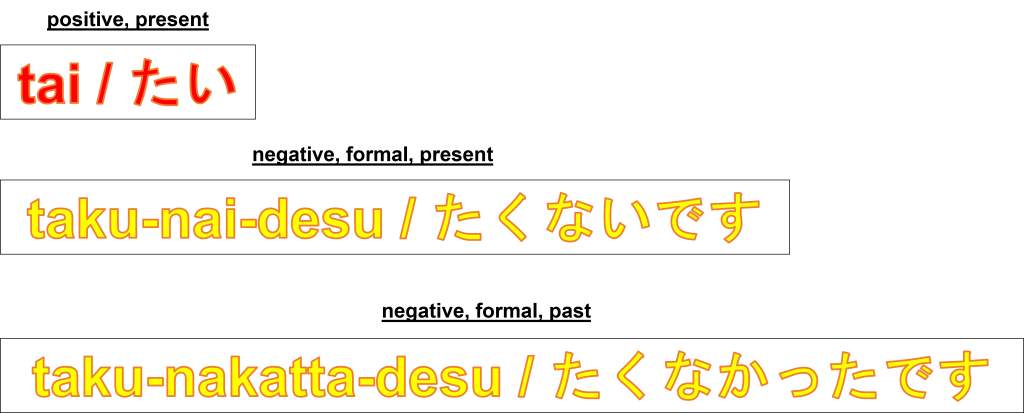
Let's look at some examples:
<Example 3>
Tookyoo ni iki-tai.
とうきょう に いきたい。
東京 に 行きたい。
[Tokyo ni/に go-want]
I want to go to Tokyo.
Tookyoo ni iki-taku-nai-desu.
とうきょう に いきたくないです。
東京 に 行きたくないです。
[Tokyo ni/に go-want-not-polite]
I don't want to go to Tokyo.
Here, "taku-nai-desu/たいです" which is the negative formal "tai/たい" follows "iki/いき" which is the i form of "iku/いく."
<Example 4>
Eega wo mi-tai.
えいが を みたい。
映画 を 観たい。
[movie o/を watch-want]
I want to watch a movie.
Eega wo mi-taku-nakatta-desu.
えいが を みたくなかったです。
映画 を 観たくなかったです。
[movie o/を watch-want-not(past)-polite]
I didn't want to watch a movie now.
Here, "taku-nakatta-desu/たくなかったです" which is the past form of "taku-nai-desu/たくないです" follows "mi/み" which is the ru-dropping form of "miru/みる."
You may also like
https://jpgrammar.com/nai/



